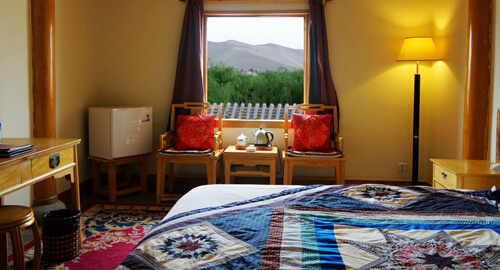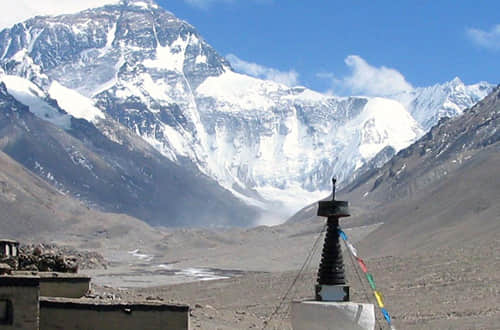7 Days Lanzhou, Zhangye, Jiayuguan and Dunhuang Tour
Gansu is a long, narrow province located in northwestern China. For centuries, it was the vital corridor between China and Central Asia and was considered the ‘gold sector’ of that international route. As an important province on the Silk Road, this place offers anyone who wants to visit, a historical and cultural encounter of ancient monuments that are scattered along the Silk Road. Gansu’s territory overlaps with Qinghai-Tibet Plateau, the Inner Mongolia Plateau; the Loess Plateau, which give Gansu diverse landforms such as grasslands, deserts, and, most notably, its unique Danxia landforms. Along with the Han ethnic people, Gansu is also home to Hui, Tibetan, Yugu, and many other ethnicities. Many of these ethnic groups, though blended into Han identity, have maintained their distinct linguistic and regional cultural traditions, which can be found from their food to the arts.
This 7-day tour focus on cities along the Silk Road in Gansu Province. You’ll visit the highlights these cities offer. This tour can be customized to meet your need. You can also extend it westward to include the Xinjiang area.
Highlights of The Tour
#1 Visit the westernmost section of the Great Wall –Jiayuguan Pass, also one of the largest passes on the Great Wall. 
#2 Discover the unreal “Rainbow Mountain”, known for its otherworldly colors that mimic a rainbow painted over the tops of rolling mountains. 
#3 Hiking in Pingshanhu Grand Canyon- a small version of the Colorado Grand Canyon in China. 
#4 Immerse yourself in the Buddhist heritage of the Bingling Temple Grottoes in Lanzhou and Mogao Caves in Dunhuang. 
Full Itinerary
Make your own way to Lanzhou (Lanzhou Zhongchuan International Airport IATA: LHW) either by flight or train. Upon your arrival, your English-speaking guide and driver will pick you up and take you to your hotel. The rest of the day is free for you to explore the neighborhood. You can enjoy a hearty bowl of Lanzhou beef noodle soup for lunch, a popular local delicacy.
Lanzhou is the provincial capital of Gansu Province and a key regional transportation hub in northwest China. Historically, it has been a major link on the Northern Silk Road and it stands to become a major hub on the new Eurasian Land Bridge.
After breakfast at your hotel, you will be taken to the Binglingsi Grottoes, 80 km away. Binglingsi translates to “Cave of the Thousand Buddhas” –a complex of rocky caves built around 420C E. It is one of the few Buddhist grottoes in China to have survived the tumultuous 20th century unscathed. Located on the cliff of Liujiaxia Reservoir, a boat ride taking 50 minutes is required for you to get to the grottoes. The ride offers you excellent views of fishermen busy at work and peasants cultivating wheat, sunflowers, and rice on the dark, steep banks. This tour will take 2 hours and the main highlight is the 27m statue of Buddha Maitreya and the wall paintings. Cave No.169 is optional and will require an additional entrance fee which is not included in our quote.
After the tour, you will return to the dam by boat and then be driven back to Lanzhou to White Pagoda Mountain. The pagoda for which the mountain is named sits atop one of the peaks and was originally built during the Yuan Dynasty in memory of a Tibetan Buddhist Lama. It was rebuilt during the Ming Dynasty and has a combination of Han and Tibetan architecture-style which makes the pagoda very unique in China. Zhongshan Bridge, also known as Yellow River Iron Bridge, was built in 1909 and was dubbed "the First Bridge over the Yellow River" is your next stop.
Tips: Lunch is included in your tour, however as there are no restaurants near the grottoes we suggest that you either have an early lunch at 11 am before boarding the boat, or a late lunch at 3 pm after the tour.
Today you will travel to Zhangye by bullet train, a 4.5 hours journey. Zhangye was an important city on Silk Road, and today is recognized as the home of Zhangye Danxia Landform Geopark or otherwise known as “Rainbow Mountains.” On arrival at Zhangye, you will head to the Geopark approximately 40 km east of Zhangye City. These interesting rock formations feature an array of colors - red, orange, and yellow. If the weather is good, you may enjoy the beautiful scenery as the sunsets across the mountains.
Put your hiking boots on, as this morning you will head out to the Pingshanhu Grand Canyon, a hidden gem and not known by many people even in China. Spires and columns of brick red sandstone stretch across as far as the eye can see. You can enjoy a panoramic scene of the canyon from the viewing platform before you embark down to the canyon floor to begin your hike, then return to Zhangye for lunch before going to Jiayuguan, a 3.5 hours drive. On arrival at Jiayuguan, there is a visit to Jiayuguan Pass, the westernmost limit of the Great Wall. The pass is strategically located in the narrowest point of the Hexi Corridor, and for centuries, was a busy hub for the commercial and military routes of the Silk Road. Take a climb to the top of the pass and view the Gobi desert. Your day will end at Jiayuguan where you will stay for the night.
Today, your tour will take you to Dunhuang; visit the Suoyang City Ruins en route. Suoyang City Ruins was inscribed on UNESCO's list of World Cultural Heritages in 2014. Built during the Han Dynasty (202BC-220AD), this border town prospered in Tang Dynasty (618-907). Suoyang City became deserted after the closure of the Jiayuguan Pass in 1524. There are towers, houses, lanes, and city walls that can be seen today in the city ruins.
After the visit, you will proceed to Dunhuang which for centuries, was a key outpost on the ancient Silk Road, providing shelter and respite for weary traders along the route east to west or vice versa. The tour will include a visit to the Echo Sand Mountain & Crescent Moon Lake; climb up to the highest sand dune, to capture a birds-eye view of the sand and the lake. Here, you have the option of riding a camel. Tonight, you will stay at the Silk Road Dunhuang Hotel, one of the best hotels in Dunhuang, where you can enjoy the desert view from its rooftop bar where you’ll have your breakfast the next day.
After breakfast, your first stop is the Mogao Grottoes, also known as the Caves of the Thousand Buddhas. The first caves were carved into the cliffs in the 4th century AD, and the final caves were created in the 14th century. These caves are China’s oldest and richest repository of Buddhist art, with a labyrinth of over 500 caves carved out of a sandstone cliff face, more than half a mile long and 10 stories high. Each cave is a treasure trove of art, containing over 600 statues, and elaborate wall and ceiling paintings.
This visit will begin by watching 2 films in 2 different cinema rooms for about 50 minutes, giving you an account of its history, close-up graphics of the caves. A headset for English audio will be provided. Once you have finished viewing the films, take a shuttle bus ride for about 15 minutes to the caves, where another English-speaking guide will take you to see some of the caves, including the largest indoor Buddha. (Please note our guide cannot accompany you into this location, and you may be joined by other English-speaking tourists). Taking photos inside the caves is strictly forbidden, even without flash. This tour will take approximately 1.5 hours.
After the Mogao Grottoes tour, you will be taken to the Great Wall of the Han Dynasty (202 BCE - 220 CE), a 1.5 hours drive. This section of the Wall does not look like the section near Beijing. The builders of this Wall used willow branches and reeds to weave a frame and filled the frame with sand and gravel mixed with saline groundwater, piled one on top of another. You will encounter many beacon towers and piles of firewood that were kept near the towers, in the event that when they saw their enemies approaching, a fire was lit to warn the people.
The next stop is the nearby Jade Gate Pass. During the Han Dynasty, this was a key spot on the Silk Road. It was the westernmost Chinese outpost and the entrance to the Silk Road in China. In 1907, British archaeologist Aurel Stein discovered a group of eight letters, written on paper, known as the Sogidan "Ancient Letters" just west of the Jade Gate Pass.
Sadly, your tour ends here, where you will be taken to the Dunhuang train station or Dunhuang Airport (DNH) for your next destination.
Tour Notes
This tour takes you on a journey through time and how Buddhism gradually penetrated China through the trading routes. Once you have booked your own transportation to Lanzhou, let us know and we can help you plan your trip to follow and explore the trails of the earlier traders and merchants.
Featured Hotel




What’s Included
- Experienced tour guides
- Entrance fee to all spots listed in the itinerary
- Well selected hotel accommodation
- Meals mentioned in the itinerary
- Expert drivers and comfortable vehicles with air-conditioning
Wechat & WhatsApp: +86-13471279378




